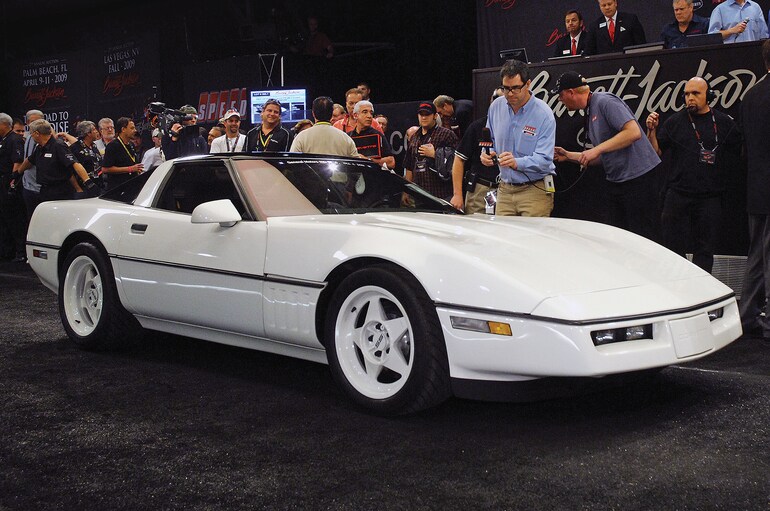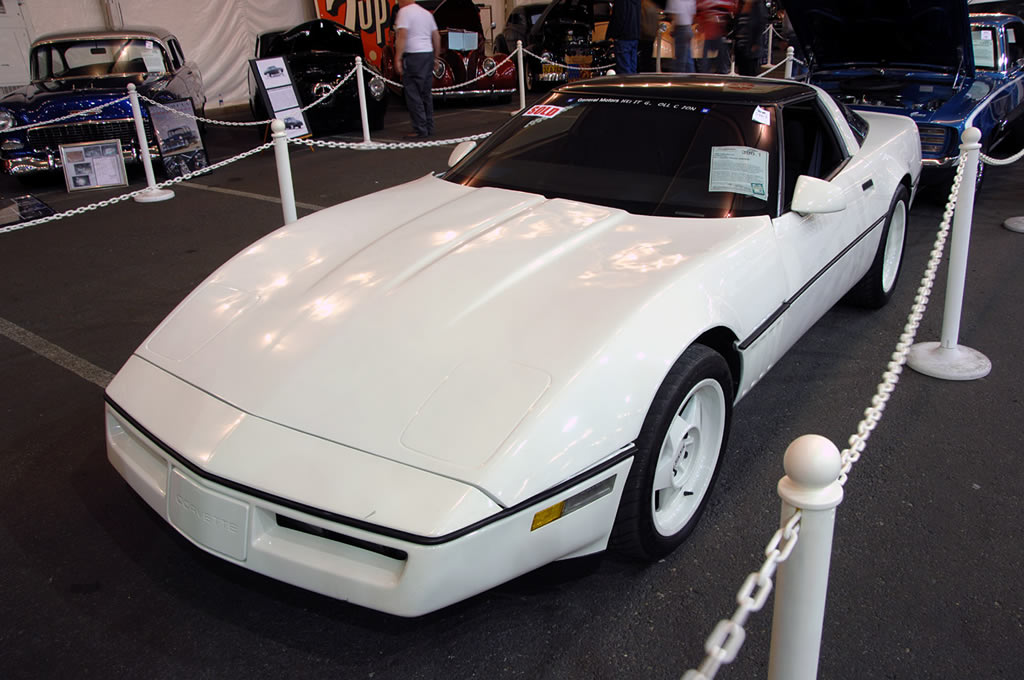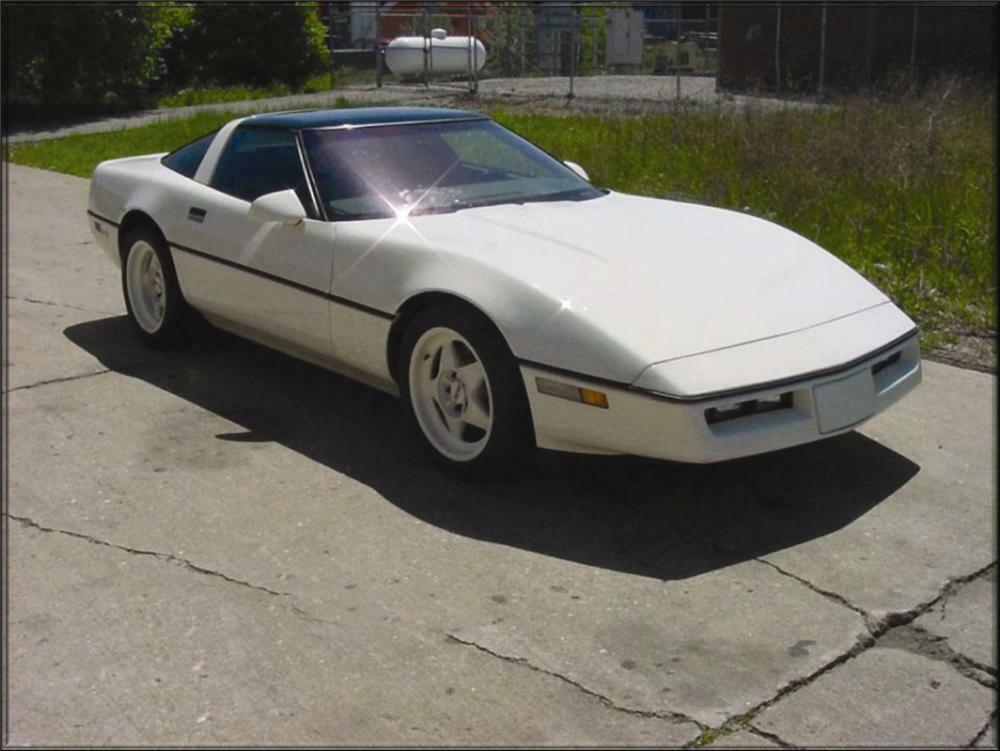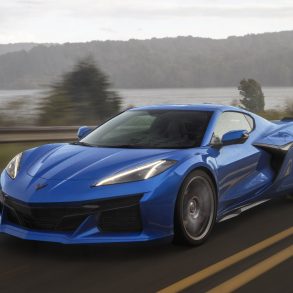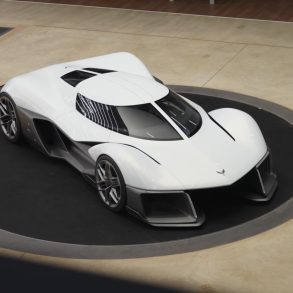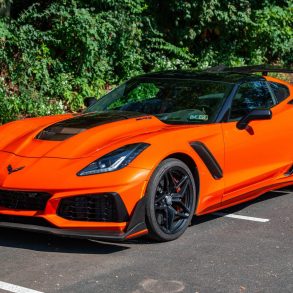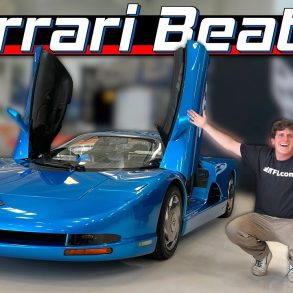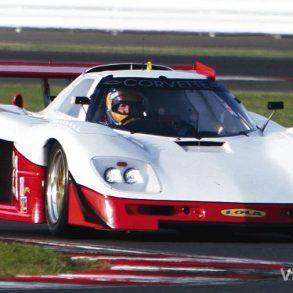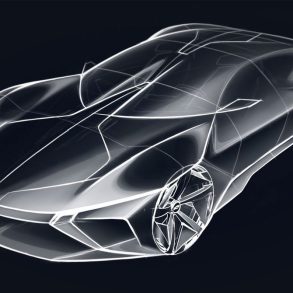1989 ZR-1 Snake Skinner – Aka The ZR-1 SS Prototype
At their 2009 Scottsdale, Arizona sale, Barrett-Jackson auctioned some GM Hertitage Collection cars, most under scrap titles. Among them was this factory lightweight ZR1 that was tested for possible production. It sold for $176,000.00 USD. John Heinricy said the car was lightened with “things like magesium roof frames, carbon fiber hood, carbon brakes, magnesium wheels, lighweighting from one end to the other. Futhermore it has an LT5 Mercury Marine black engine and Lexan windows.
The auction description was as follows:
One of 83 production 1989 ZR-1s built in Bowling Green. This experimental light weight was aimed directly at maintaining Corvette’s performance supremacy. With a 475hp LT5 V8 and less weight, this vehicle is GM Performance legend. Sold on a Scrap Title.
Led by Corvette Executive John Heinricy, this experimental light weight was aimed directly at maintaining Corvette’s performance supremacy. With a 475hp LT5 V8 and less weight, this vehicle became a legend at GM Performance. It all started with a factory test mule. The experiment was to see how a ZR-1 would perform if given more power and less weight. The end product resulted in a ZR-1 that was so fast it was named the “Snake Skinnner”, for it’s ability to out-perform the Viper and legendary Cobra.
While this car looks stock in appearance it is very deceptive. Deep in it’s secluded desert hideout, this Corvette underwent a metamorphosis of grand proportions. The fiberglass hood was replaced with a high tech Kevlar hood with half the weight. The rear window was plexiglass. No air-conditioning, no radio, and no other power amenities were included in this “Mongoose” of a Corvette. The engine is this “SS” very unique.
The LT-5 ZR-1 engine retained it’s original displacement. However, it’s what’s inside that counts. The cams were advanced in timing a bit, the intake throttles were modified so that all ports would flow equally and headers were bolted up to the aluminum block to increase the airflow out of this beautiful engine. A black crackle finish was placed on the surface of the engine to reveal it’s secret identity. At first only 440 HP was stated, but later, 475 NET Horsepower was advertised.
Let’s take a look at some figures:
- 0 – 60 MPH: 3.6 sec.
- 0 – 100 MPH: 7.8 sec.
- 1/4 Mile: 11.8 sec. @ 123 MPH
- 0 – 100 MPH – 0 MPH: 12.8 sec.
- Cornering: 1.05 g’s
All of this was done with a set of Goodyear Eagle GS-CS tires, the “S” stands for “sticky”, which were mounted on a set of Dymag magnesium wheels. This type of dynamic performance was a bit too much for corporate executives, so the Snake Skinner never became a factory option.
Enter the “Tuners”…
Both Doug Rippie and John Lingenfelter received the data required to build their own Snake Skinners. Not content with leaving well enough alone, provided LT-5 engine packages that not only delivered 475 HP with the original displacement, but also provided LT-5’s that were “stroked” to 368 cubic inches and pumped out 565 Horsepower!
Skinning the Snake
In December 1990, I was at GM’s enormous Milford Proving Ground (MPG), 35 miles northwest of Detroit, to interview then-Corvette Development Manager John Heinricy for Corvette Quarterly magazine. “Heinrocket,” as he’s known for his motorsports accomplishments, detailed three projects his engineers had going that might affect future Corvettes.
- Light-weighting: In the mid-’90s, due to decreased fuel economy from weight added to meet new safety regulations, the gas-guzzler tax was a real threat. At the time, GM policy was firm: no guzzlers. Without weight reduction, the Corvette’s only way around the tax was reduced performance, and that wasn’t going to happen. The first project explored lightening the Vette to improve both its speed and efficiency.
- Viper response: Dodge’s reboot of the 1960s Cobra idea—light weight, brutal power and technological simplicity—was coming in about a year. Heinricy wanted to study a lighter ZR-1 in case Chevrolet needed to “skin that snake.”
- Inspiration: Heinricy wanted a project that could inspire and be a team-builder for his development engineers.
The C4 Gets Serious
Originally published on Corvette-Mag. This article from Corvette-Mag goes into lots of detail so we wanted to share it here. Definitely check out the original when you get a chance.
As these programs had some common goals, it made sense to use a single car. In mid-June 1989, Chevrolet’s 1990 media preview used non-saleable ’89 ZR-1s. A white car with a red interior (VIN 00081) caught Heinricy’s eye. After the press show, he assigned it to the three-part project.
To start, the car’s A/C, sound system, tire-pressure warning system and spare tire were scrapped. Lighter cloth seats replaced the leather units, and the stock wheels were pitched for magnesium Dymags. A standard flywheel replaced the heavy dual-mass wheel, and a magnesium clutch housing was used instead of the aluminum stocker. The car’s structure aft of the rear suspension was replaced with aluminum, and the roof received a magnesium frame. At this point, the lightened ZR-1 was down 250 pounds to about 3,200.
The engine was a stock, 375-hp LT5 that had been up-rated to 400 hp via slightly different cam timing, a revised ECM calibration, deleted catalytic converters and racing mufflers.
Zero to 185
Later that cold December afternoon, Heinricy and I were in this first iteration of what was then informally known as Snake Skinner, headed for the “North/South,” a three-mile straight running along MPG’s western edge. At the south end, we sat with the engine idling. While my pulse raced, Heinricy exhibited zero emotion. He had more Corvette seat time at 170-plus mph than almost anyone on Earth, having teamed with seven other drivers to set the 24-hour World Land Speed Record at 175.885 mph earlier in the year.
Frigid weather made for lots of power, and Snake Skinner’s Goodyear Gatorbacks were not sticking well. Even with a rolling start, the car wanted to spin the tires like crazy. In Second, Heinricy squeezed on the power, still trying to get traction. Finally, the car hooked and he was able to mat the throttle. With no cats and racing mufflers, the four-cam LT5 sounded completely insane. Shifting at 6,800 rpm in Second and Third, we covered most of the first mile in about 30 seconds and neared the top of Fourth gear at 150.
A shift to Fifth put the LT5 at peak torque. Speed rose more slowly, so the engine screamed seemingly forever. As an ’89, the car had the early-C4 digital dash, so I watched the numbers flash…165, 175. Tunnel vision, howling exhaust and wind noise—all primal-scream therapy for a true believer in the Corvette mystique. With maybe a mile and a quarter left, and speed slowly gaining—183…184…185—Heinricy finally lifted.
I remember that run in Snake Skinner 28 years ago like it was yesterday. It was the fastest I’ve ever gone in a car.
More, and Less
In January 1991, Snake Skinner was shipped to the Desert Proving Ground (DPG) in Mesa, Arizona for the winter. Corvette Project Coordinator Scott Leon, whom we met in part two of this series, oversaw further modifications. The hatch was replaced with Plexiglas in an aluminum frame. A lightweight Kevlar hood was installed. The headlight assemblies were scrapped and their doors sealed. Mini-quad headlights and turn signals from a Pontiac Grand Prix were fitted to the stock signal and fog-light mounts. The compartment doors behind the seats were replaced with a Lexan panel. There were other small reductions as well, too numerous to mention.
A special LT5 supplied by engine manufacturer MerCruiser was installed. Its lower end was stock, but there were numerous alterations elsewhere. The cylinder heads’ secondary-port throttle hardware was discarded, while the heads themselves were ported, polished and fitted with more-aggressive camshafts. The injector-housing ports were converted from two small to one large opening—a treatment known as “siamesing”—while the plenum was ported and its outlets also siamesed. The throttle-body barrels were enlarged, headers were added and the exhaust-system resonator was removed. Finally, the ECM calibration was updated and its rev limit raised to a screaming 7,500 rpm.
This engine, powder-coated all black, reportedly produced 475 hp. Interestingly, that was the same number cited for eight engines produced in the spring of 1993 for the “Black Engine” program, a 50-state-legal, LT5 tuner version developed by MerCruiser and Doug Rippie Motorsports. I strongly suspect that Snake Skinner’s final engine actually made closer to 500 hp due to its headers, lack of cats and no resonator.
The stock 3.54:1 gears were exchanged for a set of 3.91s. S-Compound Goodyear VR Eagle showroom-stock racing tires were fitted to the Dymags, more-aggressive brake pads were added and the Selective Ride Control software was altered. Otherwise, the excellent ZR-1 chassis was left alone.
The fuel tank was replaced with one having more capacity and better baffling to prevent starvation in turns at low fuel levels. Finally, Leon added a couple of appearance items: four-louver fender vents from the Chevrolet Raceshop’s Corvette Aero Kit and a set of 1992 LT1 exhaust outlets.
Driving the SS
During a May 1991 visit to Mesa for Road & Track magazine, I had a chance to try out the car myself. Spring evenings at DPG were pleasant, and sunsets on the Superstition Mountains were an exquisite sight. Snake Skinner, 100 pounds lighter since my last encounter, was sitting on the facility’s acceleration strip for photos and quarter-mile testing. At 3,100 pounds, with 475-plus horses and short gears, the car was devilishly difficult to launch. I made six passes and never got it right, but I had a lot of fun trying.
Fire up Snake Skinner, and right away you knew it was not for the faint-hearted. The idle had a race engine’s lope, the exhaust note was nasty and throttle response was abrupt to the point of being almost too quick. I closed my eyes and enjoyed the sound as I waited for the oil temperature to come up.
I rolled up to the line, revved the engine to 2,800 and popped the clutch. That blew the tires away and banged the limiter. The next launch was better, but this time I tagged the limiter on the One-Two shift. Leon told me that the lag from the digital tach in First was such that, to shift at 7,400, you had to pull the lever when you saw 6,200.
For the next four runs, I stayed off the limiter and did better, but still not great. A hard pass in Snake Skinner depended on rapid, but not sudden, clutch release, followed by careful balance of throttle and wheel spin. My best effort was a 12.36 seconds at 116.8 mph. With darkness approaching, I put Leon in to see if someone who’d driven the car a lot could do better. He did, to the tune of 12.22 at 118.6.
Earlier that day, we’d used the acceleration strip and the vehicle-dynamics pad for other tests. Snake Skinner averaged 1.01g on the skid pad and ran through a 700-foot slalom at 64.4 mph. The car was balanced, with less understeer than a stock ZR-1. Due to less weight and better response from the S-tires, it was great fun in the constant transitions typical of slaloms. The car might have done even better had its de-contenting plan included a modification to reduce ride height. As it was, the car rode higher than stock due to the lack of weight acting on the factory suspension components.
The next day, Leon and I took a trip on public roads. First, we went up Arizona 88 into Tonto National Forest northeast of Mesa, a great road featuring lots of twists linked to short straights, with elevation changes mixed in. The car’s crisp transitions and neutral balance, combined with good predictability, made it easy to drive near the limit. On the straights, power and gearing made it a rocket ship. Squeeze the gas a bit too soon or too hard exiting a corner and you got power oversteer, with no advanced electronic aids to bail you out.
We also drove into Phoenix to see what Snake Skinner was like in an urban setting, and it proved reasonably friendly. The car never ran hot, and drivability was generally quite good. Downsides? Well, maybe it was a bit noisy for cruising, and I missed having a stereo.
Cobra Killer
During the winter of 1991-1992, Snake Skinner was further developed with a lighter alternator, a single cooling fan, a smaller battery, lightweight half-shafts, a thinner thickness and side glass, and magnesium side-view mirror housings. The center console was removed, while the carpeting and sound deadener ahead of the rear bulkhead were replaced with lighter materials. Lightened bumper beams and many other small weight reductions were also included. According to information supplied by Leon, by March of 1993 the car weighed just 2,906 pounds. Around that time, the Corvette development team’s straight-line specialist, Jim Ingle, drove it to a 12.04-second quarter mile at 122.2 mph.
A final round of mods occurred in 1993, among the more significant of which were a titanium exhaust system and experimental carbon-ceramic brake rotors. By then, the car was down to just 2,765 pounds, light enough that Ingle managed an 11.88/123 quarter and a 3.6-second zero-to-60 time. Even more impressive, Leon piloted Snake Skinner to a 12.8-second 0-100-0 run, handily beating the 427 Cobra’s long-standing record of 14 ticks. (Incredibly, Corvette brake-systems engineer Jack Gillies was riding shotgun at the time, which suggests that an even quicker run might have been possible.)
“Heinrocket” Reflects
In October 2018, I did a phone interview with John Heinricy for this article. His Snake Skinner stories could fill several pages. “I really liked driving it for daily transportation,” he told me, “as it was so lively and responsive, but it wasn’t really my company car because other engineers and media also drove it.
“One time, I was on M59 [a four-lane highway north of Detroit] over near Rochester Hills, going to pick up [my girlfriend]. There was no traffic, [and] I came up on a Gen 1 Camaro—big tires on the back, little tires on the front, a tall hood and…nitrous. We never looked at each other. We ran through the gears from a slow roll, maybe four times. It was close, too. He got me twice, and I beat him twice.
“Another time, coming home from the airport, it was raining hard [and] I was driving too fast on I-96. We hydroplaned into a ditch, luckily missing all the trees, but got stuck in the mud. Four guys saw us go off and stopped. In the pouring rain, they pushed us out. The car shook so bad from grass and mud jammed into the rims, it was undrivable over 30 mph. I got to Milford the next morning and weighed the car. It had several hundred pounds of mud. I power-washed it for a couple hours to get the mud off before it dried. Then, I got the tires off to clean the rims.
“Oh, and then there was the time it was stolen. That was in [August] 1992. The car was in Canada for a promotional event at Mosport. It got stolen from a hotel parking lot.”
Local media reported that the next day, 45 miles away in Toronto, police spotted the car and a short pursuit ensued, after which two suspects bailed out and were taken into custody. The driver door’s latch mechanism had been forced, and there was damage to the steering column, but otherwise Snake Skinner was no worse for wear. It was returned to GM and repaired.
Heinricy went on to note that the final instance of Snake Skinner’s use for development purposes was a late-1994 drive session that he and then-Chief Engineer Dave Hill did at DPG. By then, C4 development work was complete and engineers were focused on the 1997 C5. In the longer term, Hill and Heinricy were brainstorming higher-performance C5s, and for that they needed the ultra-light, ultra-powerful Snake Skinner.
In the end, Snake Skinner’s effect on C4 development was not great, but some of its concepts made production in future Corvette generations. Most significant were its magnesium roof frame and wheels, lightweight glass, titanium exhaust, 500-hp engine, aluminum structure and carbon brake rotors.
Snake Skinner also became popular on the promotional circuit—so popular that GM eventually built a “Snake Skinner II,” featuring the appearance modifications but little of the light-weighting and performance upgrades, for show appearances. In the post-C4 era, the car was lent to the Corvette Museum until late 2008, when GM retrieved it for a sale of assets prior to its June ’09 bankruptcy.
In January 2009 at Barrett-Jackson’s Scottsdale auction, Snake Skinner sold for $176,000 to auto-dealership magnate and noted Corvette collector Rick Hendrick. Today, the car is kept in a museum on the Hendrick Chevrolet/Hendrick Motorsports campus in Charlotte, North Carolina.
Snake Skinner project manager John Heinricy, meanwhile, went on to become Corvette assistant chief engineer and then director of high-performance vehicle operations for GM’s Performance Division. He retired in 2009 and formed a consulting firm, Heinrocket, Inc. specializing in engineering consultation, driving instruction, racecar development, vehicle forensics and inspirational speaking. His accomplishments in motorsports—three FIA world records, four professional racing championships and 13 SCCA National titles—are the stuff of Corvette legend. In 2014, he was inducted into the National Corvette Museum’s Hall of Fame, a fitting tribute to a man who never stopped honing the marque’s performance edge.
